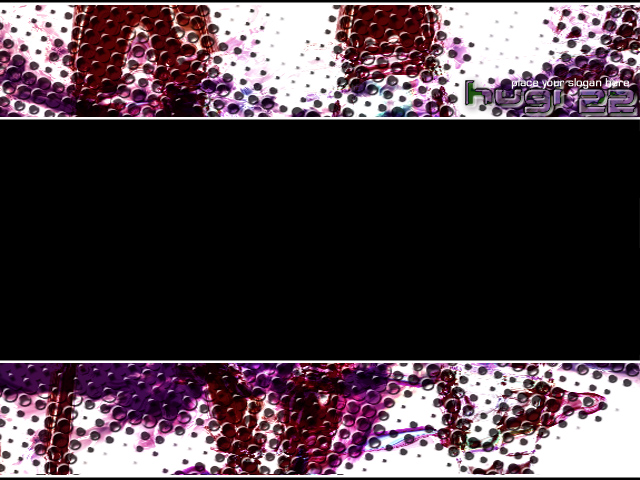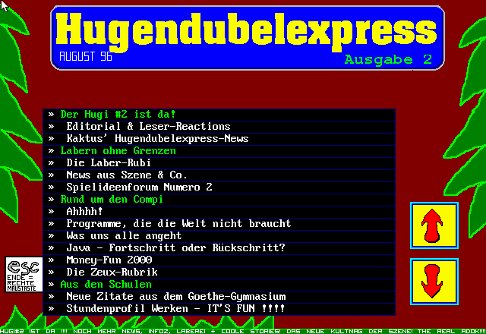
What does the future hold for Hugi?
This article is going to be a summary of the development of Hugi since the day it was founded, and at the end I will pose the question to the readers how they think Hugi should develop in the future.

When Hugi was founded in 1996, it was not conceived as a demoscene magazine. Rather it was a kind of "electronic school kiddy magazine" that was deliberately "open for all topics" and dealt with anything its authors wanted to write about. When the word "scene" appeared in these early issues of Hugi, not the demoscene, but the large community of all sorts of computer freaks was meant.
When I decided to focus on the demoscene after the 10th issue of Hugi, this was because I was closely following the scene, noticed that there was a vacuum due to the demise of the Imphobia magazine, which had been the only significant international PC diskmag related to the demoscene in the early 1990s, and was convinced by various people that it would be a good idea to create a new demoscene related magazine. So Hugi #11 appeared in June 1998, and although it carried issue number 11 it was a completely new magazine with a totally different kind of contents as the previous issues, and it attracted a different kind of readers and contributors. In retrospect I think the move to the demoscene has been a very good decision because this gave us access to an outstanding pool of talented graphics artists and musicians who contributed to Hugi on a voluntary basis and laid the foundation for a great visual and auditory experience while reading the magazine. Already for Hugi #11 we managed to get Antony of Pulse to create the opening picture and in issues after that people such as Cereal, Scape, FloOd, Hellfire, Bridgeclaw, Amoivikos and Critikill were responsible for the visual design of Hugi. For the music we also attracted great names including Moby, Siatek, Chromag, Jogeir Liljedahl, Romeo Knight, Traymuss, Acumen and many more.
Audiovisually Hugi has been top since the move towards the demoscene, and from issue 18 on we also had a great magazine engine developed by Chris Dragan, which has so many nice features while being stable and easy to use that it has been used in Hugi issues for more than 10 years, and is still being used, almost unmodified.
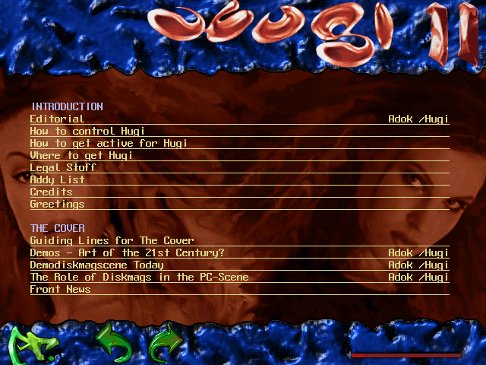
Four Generations of Hugi
Looking at the history of the Hugi Magazine from today's point of view, one might distinguish between four generations of the magazine. There have been four epochs varying mostly regarding the type of contents of the magazine. The engine of the Hugi Magazine has changed as well over time, but these changes have been of minor importance for this grouping of the issues. In the following section of this article I would like to explain why I would make this distinction. I am aware that this will be of little interest for anybody except for true fans of Hugi.
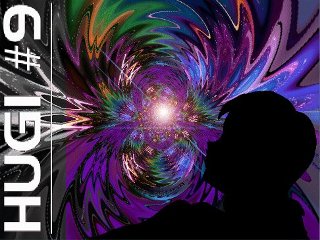
First Generation (1996 - 1998)
The first generation of Hugi are the ten first issues:
# Hugendubelexpress 1 (May 1996)
# Hugendubelexpress 2 (August 1996)
# Hugendubelexpress 3 (November 1996)
# Hugendubelexpress 4 (February 1997)
# Hugi 5 (March 1997)
# Hugi 6 (May 1997)
# Hugi 7 (July 1997)
# Hugi 8 (October 1997)
# Hugi 9 - The Next Generation (December 1997)
# Hugi 10 (April 1998)
These were the days when the magazine was released in the German language. As the subtitle of Hugi 9, "The Next Generation", implies, its contents were slowly starting to change at the end of this period - the next generation was to come. Hugi 9 contained a small English corner with focus on the demoscene. This was the harbinger of the transformation of the former "electronic school magazine" to an international magazine that tried to cover all aspects of the demoscene. However, Hugi 9 did not gain much attention outside the German speaking community. This was to change with issue 11, which was the real first issue of the second generation of the Hugi Magazine.
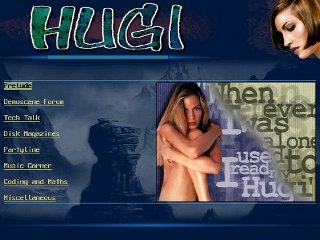
Second Generation (1998 - 2001)
The second generation comprises issues 11 to 23:
# Hugi 11 - Obscene Scene Magascene (June 1998)
# Hugi 12 - The Huge Disk Mega Zine (September 1998)
# Hugi 13 - For Educational Purposes (November 1998)
# Hugi 14 - Hugi in Afghanistan (February 1999)
# Hugi 15 - Whenever You Are Alone (May 1999)
# Hugi 16 - The Royal Scene Magazine (July 1999)
# Hugi 17 - For International Affairs (August 1999)
# Hugi 18 - The Eminent (December 1999)
# Hugi 19 - The Superior (April 2000)
# Hugi 20 - The Source of Life (August 2000)
# Hugi 21 - The Devil Family (December 2000)
# Hugi 22 - Eternal Sunshine (April 2001)
# Hugi 23 - Alone in the woods (August 2001)
This was the peek period of Hugi. In these days all issues had more than 800 kbytes of articles (many of them even much more than 1 Mbyte), and Hugi was quite popular among people involved in the demoscene. The language was English, with issues 11 to 17 having a (small in comparison) German section, and some issues (starting with Hugi 16) were even translated to Russian. Moreover, a newsletter called HugiNews was released in this time (from September 1998 to July 2000, to be more precise). While the first issues of this newsletter focused on the progress of the work on Hugi, the later issues covered news about the demoscene in total.

Third Generation (2002 - 2005)
The third generation is issues 24 to 31:
# Hugi 24 - The Shift (January 2002)
# Hugi 25 - Fairy Power (July 2002)
# Hugi 26 - Techno Tarantula (February 2003)
# Hugi 27 - The Freedom Diskmag (July 2003)
# Hugi 28 - The Unnamed One (December 2003)
# Hugi 29 - The Blue One (August 2004)
# Hugi 30 - Scene Substance (February 2005)
# Hugi 31 - Friendship is all (November 2005)
While I was spending a hard time studying at university, Hugi was released less regularly, and while some of the issues were as big as in the past (e.g. Hugi 26 with 1 Mbyte of articles), some were rather small (e.g. Hugi 29 had only 520 kbytes of articles). I did not have time any more to watch the demoscene as closely as I had been able to in the past, which is reflected by the contents of these issues. Nevertheless I would say that most of these issues have been pretty okay.
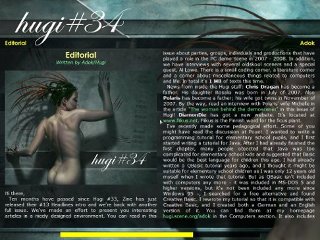
Fourth Generation (since 2006)
The fourth generation is the current generation, and at the time of writing this, it consists of the following issues:
# Hugi 32 - Say It With Flowers (August 2006)
# Hugi 33 - MP3 Power (April 2007)
# Hugi 34 - World of Scene (February 2008)
# Hugi 35 - Disruption of Chaos Theory (November 2008)
# Hugi 36 - Jukebox Delight (April 2010)
These are the issues which have been more or less directed by Magic, who took over a lot of the work I used to do in the past (organizing, writing, making interviews), while I focused on technical aspects and proofreading. Hugi has become even more demoscene-oriented than in the past, and also the level of graphics and music has improved due to use of more modern technology (higher resolution, streamed music). The issues have become larger again as well.
Pouet feedback analysis
The following lines contain an analysis of the feedback on the individual Hugi issues that was posted to pouet.net short after their respective release. It is supposed to answer the question whether the attitude of the regular readers to Hugi changed over the time, or whether the general attitude reflected by the feedback changed because more and more comments were posted by people who had previously not been (regular) readers of Hugi. Until issue 25 most of the feedback on Hugi was sent to staff members via email. From issue 26 on pouet.net became the primary feedback repository, and few people bothered to actually contact us to tell us about their impression of the respective most recent issue. The following analysis mostly reflects on the period of transition.
Hugi issues 1 to 19 were added to pouet.net short after pouet.net went online, as we can see by the low production ID numbers. The comments were posted long after the release of the issues, so they are not relevant to this analysis (they do not reflect the feedback we got on the issues right after their respective release).
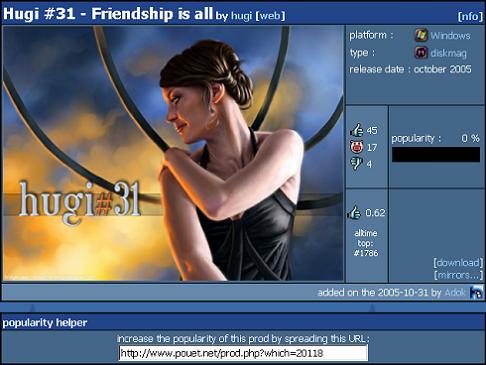
Hugi 20, from August 2000, was the first issue that was released after (or perhaps a few days before) pouet.net went online. Pouet.net had only about 75 users at that point of time. Only two comments were posted in the year the issue was released in and could therefore be considered remotely relevant. As thumbing up/down was not implemented yet, they contained no rating.
Hugi 21: There are only four comments from the period when this issue was fresh.
Hugi 22: This issue was added to the production database by me, which shows that I was already aware of pouet.net at that time. There are no comments from the relevant period.
Hugi 23 was released in August 2001. At this point of time pouet.net had about 1050 users, 14 times as much as a year before. Although the pouet.net userbase was already large, there were only two comments from the period. This shows that Hugi readers either did not give feedback on Hugi via pouet.net yet, or did not use pouet.net yet at all.
Hugi 24, from January 2002, got more feedback at pouet.net than the previous one (slightly more than 10 relevant comments). Pouet.net had about 1650 users at that point of time, a 57% increase since the release of the previous issue. Some of the regular Hugi readers had apparently found their way to pouet.net (comments are signed with familiar handles). Others who commented this issue had not given feedback on Hugi before. Regular Hugi readers tended to give positive or neutral ratings, previously unknown people tended to give neutral or negative ratings. The number of positive and negative ratings was approximately equal.
Hugi 25 received a similar amount of relevant feedback as the previous issue and again we can notice the pattern that regular Hugi readers tended to give more positive and previously unknown people tended to give more negative ratings.
Hugi 26, from February 2003, was the first issue that really got a considerable amount of feedback at pouet.net. About 3975 users were registered at that time, a 141% increase compared to January 2002. We can notice the same pattern regarding the ratings and overall it is pretty balanced again.
A possible interpretation of this is that pouet.net was visited both by regular readers of Hugi, who mostly expressed a positive attitude to Hugi, and people who had not known or not cared about Hugi before, downloaded the fresh issues when they were added to pouet.net and then commented on them (with less positive ratings).
In further issues the amount of negative feedback increased, overshadowing the positive feedback. This trend ended with issue 31, from which issue on positive feedback prevailed. One thing that is conspicuous is that the handles of the people giving feedback become uncreasingly unfamiliar, which means that more and more people who had not been involved with Hugi (that is, never sent emails with feedback or contributions) commented on Hugi at pouet.net.
Therefore it is not possible to draw a conclusion on the question whether the attitude of regular Hugi readers changed in the course of the time, but it is definitely true that many people who did not use to read Hugi on a regular basis posted comments on Hugi to pouet.net, and that the negative comments mostly came from these people.
The Future of Hugi?
So we have an excellent technical basis. Now the question is what contents should Hugi have. In the past we used to say Hugi is supposed to be a platform for its readers where they can present their ideas to a large audience. This has been the official philosophy of Hugi and indeed, in past issues many of the articles have been submitted by people from outside the staff who used the opportunity to tell a lot of sceners about their projects and ideas this way. But this has changed. In the past years forums emerged which allow a much more efficient discussion of ideas than any disk magazine could ever do. People use these forums as their platforms for presenting ideas, and this has become noticeable. We do not get many articles from readers these days, rather than that staff members have to fill the magazine with content. This is quite a radical change.
Basically we write about things we consider interesting ourselves. Still, it would be good to know what you, readers, actually would like to read about. Into what direction should Hugi develop? What should its contents be like? Please share some of your thoughts with us, so that we will not waste time conducting research and writing about matters nobody is interested in anyway, and focus on exactly what you want to read. It would be a waste to have such a great mag engine and access to such outstanding graphics and music if we did not know with what contents we should fill the magazine. So, please, mail us.
Bonus: Hugi Picture Collection
In the course of time various artists submitted far more pictures than what eventually got used in the Hugi Magazine. Some of these pictures are still waiting in the image pool to be used one day. A couple however cannot be used simply because they were made for a specific issue. As some of them are quite beautiful, I decided to make a collection and include it in this 37th issue of Hugi.
Pictures by Fabian
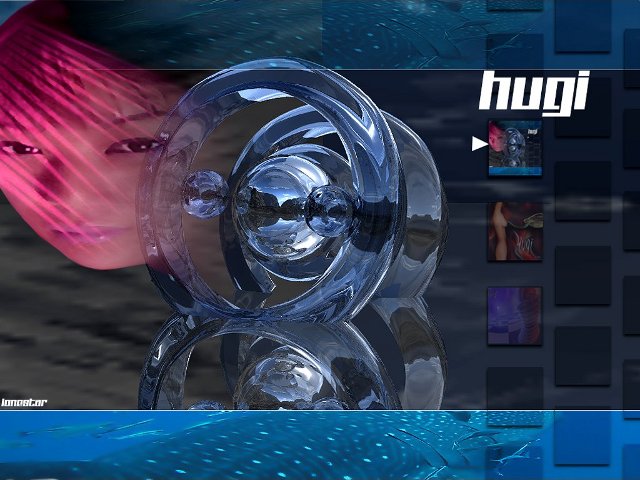
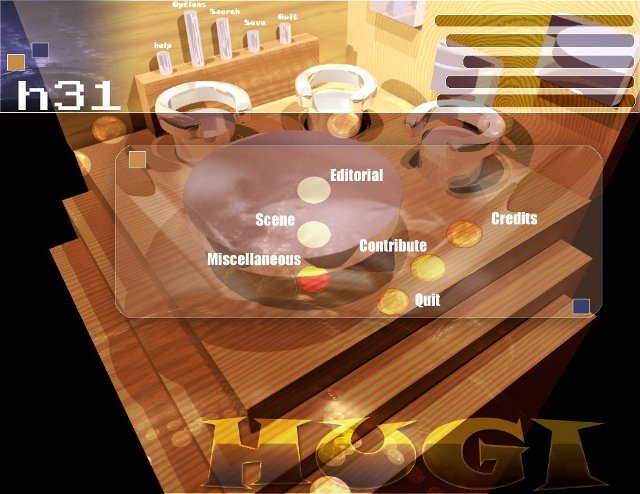


Pictures by FloOd

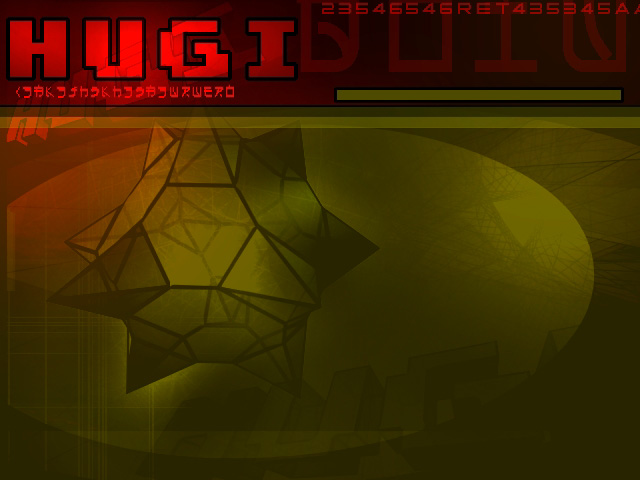
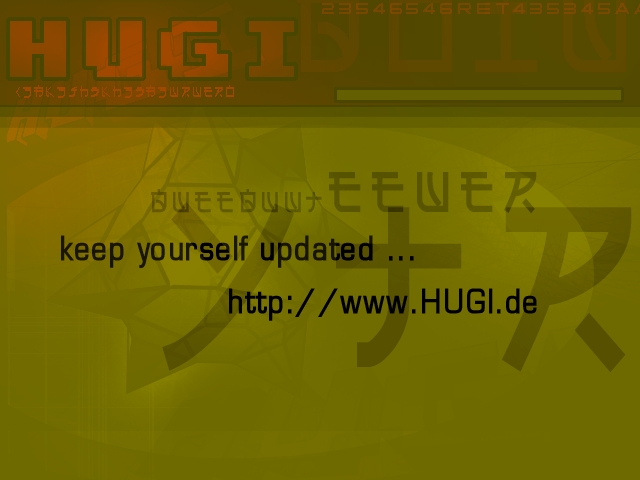
Pictures by jkole
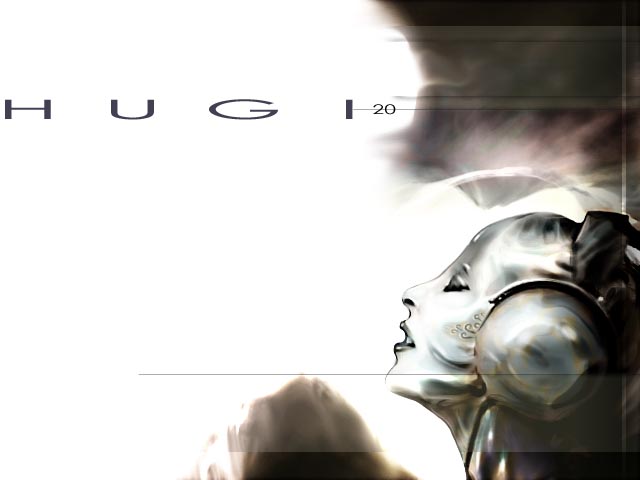
Pictures by Morph
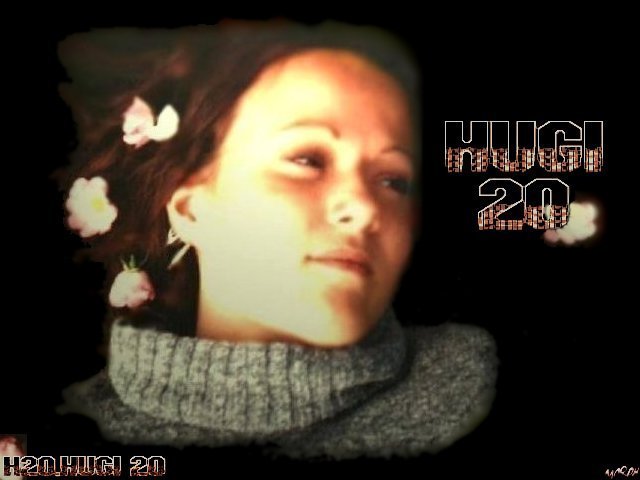
Pictures by rand0m

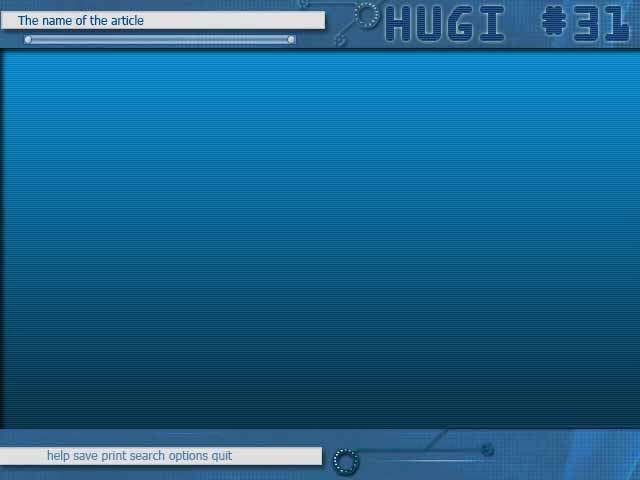
Pictures by SacRat
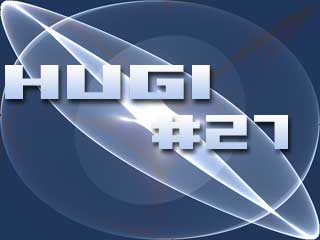
Pictures by Spin
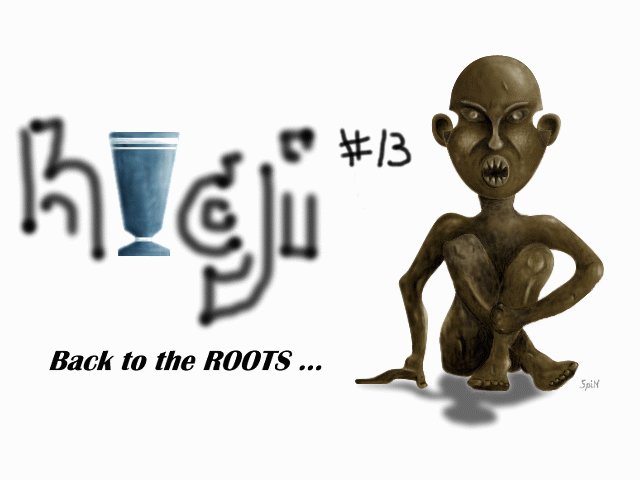
Pictures by TAD
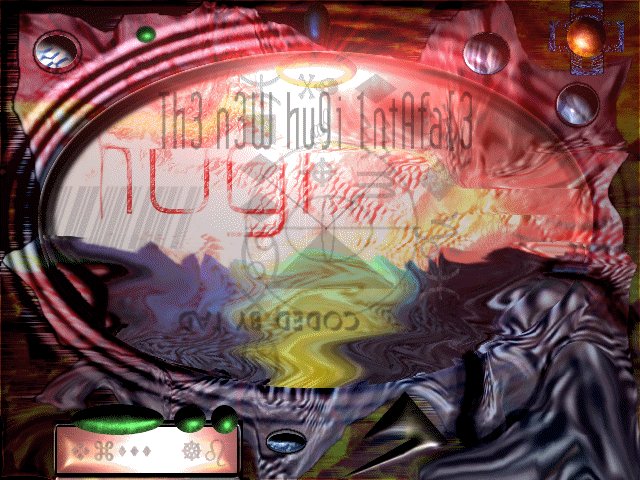
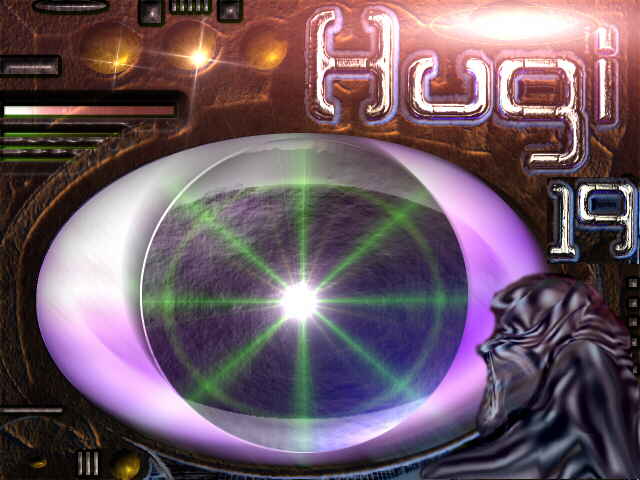
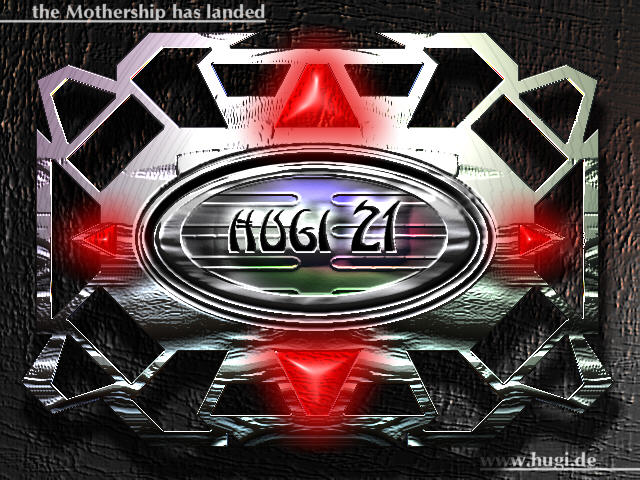

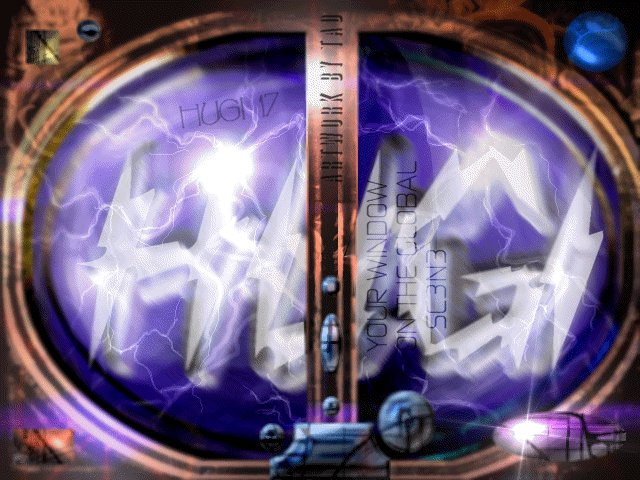
Pictures by TAD and CoaXCable

Pictures by Zealan
